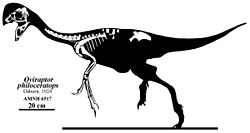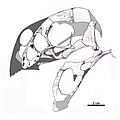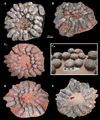Oviraptor facts for kids
Quick facts for kids OviraptorTemporal range: Upper Cretaceous
|
|
|---|---|
 |
|
| Skeletal diagram showing known elements of the holotype specimen (AMNH 6517) | |
| Scientific classification | |
| Kingdom: | |
| Class: | |
| Superorder: | |
| Order: | |
| Suborder: | |
| Family: |
Oviraptoridae
|
| Genus: |
Oviraptor
|
Oviraptor is a genus of dinosaurs from what is today Mongolia. Oviraptor was a relatively large-brained dinosaur which cared for its eggs. In 1924, an Oviraptor fossil was found on top of some eggs, and some thought that it had been eating the eggs. Others thought that the fossilized Oviraptor was probably a parent of the eggs in the nest, and not an egg stealer.
Oviraptor lived in the Upper Cretaceous period, about 75 million years ago. Only one definite specimen is known (with associated eggs), from Mongolia, though a possible second specimen (also with eggs) comes from the northeast region of Inner Mongolia, China.
Oviraptor is usually drawn with a distinctive crest, similar to that of the cassowary. However, re-examination of several oviraptorids show that this well-known, tall-crested species may actually belong to a relative of Oviraptor, the genus Citipati. It is likely that Oviraptor did have a crest, but its exact size and shape are unknown due to crushing in the skull of the only recognized specimen.
Judging by its relatives, Oviraptor probably had feathers. It had a toothless beak, but its feeding habits are unknown. The only Oviraptor fossil preserved the remains of a lizard in the region of its stomach cavity, implying that the species was at least partially carnivorous.
Images for kids
-
The Flaming Cliffs of Mongolia in the Gobi Desert. The holotype remains of Oviraptor were found in this highly fossiliferous locality of the Djadokhta Formation
-
Skeletal reconstruction of the holotype specimen. Original bones marked in White
-
Osborn's line drawing of the holotype skull
-
Restored holotype skull of Oviraptor
-
Comparison of the lower jaw of several oviraptorosaur genera
-
Life restoration of a nesting Oviraptor. Oviraptorids may have sat on their nests during incubation
See also
 In Spanish: Oviraptor philoceratops para niños
In Spanish: Oviraptor philoceratops para niños












